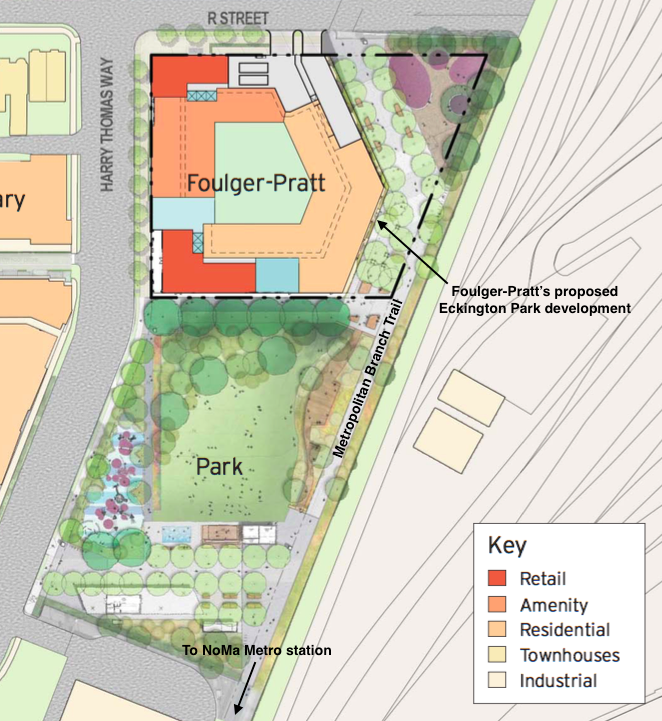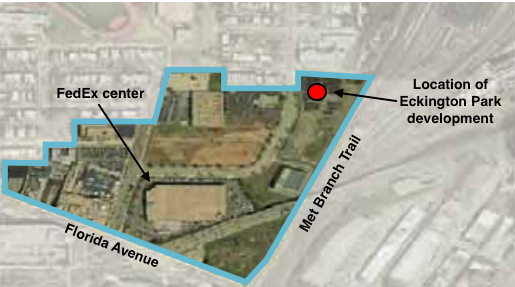Housing or industry? In this DC neighborhood, it’s a tough choice.

The proposed Eckington Park development. Image by Foulger-Pratt.
A planned new development in Eckington faces opposition on an unlikely front: its request to change the current industrial zoning to build a mixed-use residential building. Amending the zoning would keep with nearby developments, but begs the question of where Washington DC should preserve its limited industrial land, and how much it should save.
The planned Eckington Park development is located at the northwestern corner of the empty lot at the corner of R Street and Harry Thomas Way NE next to the Metropolitan Branch Trail. This is the same lot where, on the southern half of the site, the NoMa Parks Foundation plans to build its new large park.
Map showing Foulger-Pratt's proposed Eckington Park development and the new large NoMa park. Image by Foulger-Pratt.
Developer Foulger-Pratt is seeking an amendment from the DC Zoning Commission to change the zoning of the site from PDR-2 and PDR-4, which allows light industrial uses, to MU-5A, which includes medium-density mixed-use development. Such amendments are common for development in the area. For example, the Zoning Commission granted a similar amendment for the Eckington Yards development, located across Harry Thomas Way from Eckington Park, in 2016.
Industrial opposition
FedEx, which owns a large distribution center two blocks away from the proposed Eckington Park development, opposes a zoning change. In a letter to the Zoning Commission in May, the shipping company said that it will object to the amendment, citing a 1988 agreement with railroad CSX that owned the land in question at the time.
“FedEx believes the current zoning is best suited for the property and is prepared to oppose any rezoning,” a spokesman for FedEx tells Greater Greater Washington in an email.
The agreement in question created the Capital Commerce Center, an area that encompasses most of the Eckington neighborhood, and allows for signatories to develop new light industrial in the zone, according to documents filed with the Zoning Commission.
“For as long as I’ve been active in NoMa, and that is a pretty long time, I haven’t heard a thing about meetings or activities of the Capitol Commerce Center Association,” Robin-Eve Jasper, president of the NoMa Business Improvement District (BID), told the Washington Business Journal earlier in August. Eckington Park is located in the NoMa BID, which includes a portion of south Eckington.
“The whole thing seems a bit anachronistic given the terrific growth of this vibrant mixed-use community,” she continues.
Balancing industrial and residential uses
The issue of land use that faces Eckington Park is a valid one. Washington DC has a limited supply of industrial land, half of which is located in Ward 5 where the development is planned, that is under redevelopment pressure due to the city's growing population and housing affordability crunch.
This is especially true in Eckington and NoMa, which are along the popular Met Branch Trail and within easy walking distance to multiple Metro stations. While NoMa has established itself as a mixed-use neighborhood, Eckington retains multiple industrial activities and sites along its eastern edge. These include the FedEx shipping center, as well as the large District-owned lot east of the trail where snowplows and other equipment are stored.
Under then-mayor Vincent Gray, the DC government looked at the pressure facing industrial land in the city and published the Ward 5 Industrial Land Transformation Study on the topic in 2014. The report cites the economic benefits of industrial land, including job creation and providing amenities for surrounding neighborhoods, but also acknowledges the need for additional housing in the city.
A map of industrial-zoned land in Ward 5 in 2014. Image by Ward 5 Industrial Land Transformation Study.
The study recommends both preserving industrial land while allowing for new housing and mixed-use development in areas. For example, consolidating municipal properties to more efficiently use of existing industrial land and creating small-business and innovation clusters on certain industrial plots, while promoting redevelopment in transit-accessible areas, including in Eckington and NoMa.
A New York Avenue gateway
Eckington Park is located in an area that the report dubs the New York Avenue Gateway, a rapidly growing “dynamic, mixed-use hub in the District.” It recommends additional mixed-use development in this area, especially projects that include space for artists and “maker economy” businesses, ones that make goods on site, like breweries or coffee roasters.
Map of the New York Avenue Gateway area. Image by Ward 5 Industrial Land Transformation Study.
Eckington Park keeps with this vision. The project includes four two-story “live-work” spaces for artists that will be available at “affordable” levels, the developer's Zoning Commission application states. These artist units complement the maker business space planned for the Eckington Yards project next door.
In addition, eight percent of the residential units at Eckington Park, or about 26 apartments, will be priced for low-income families as part of the District's inclusionary zoning program.
What to do in Eckington?
The proposed Eckington Park development fits with what the District's vision for south Eckington. It will provide needed residential space in a sought-after transit- and trail-oriented location, and bring artists into an area where the city wants more artists and entrepreneurs.
Why FedEx is opposed to this is unclear. Perhaps they feel the additional residents could hamper their delivery service, or maybe they fear that their shipping facility could be forced out by encroaching development.
Whatever their reasons, the 1988 Capital Commerce Center agreement is an antiquated view of the kind of industrial activities that work in the District today, like light manufacturing or self-storage facilities, not mixed-use residences and small entrepreneurial businesses.
“The kind of industrial uses that were planned at the time of the covenants are not happening again in DC,” Jasper tells Greater Greater Washington.
FedEx's concerns over losing industrial land are valid but are misguided. They should be redirected to areas where DC wants such uses to thrive and not in dynamic neighborhoods targeted for redevelopment.

